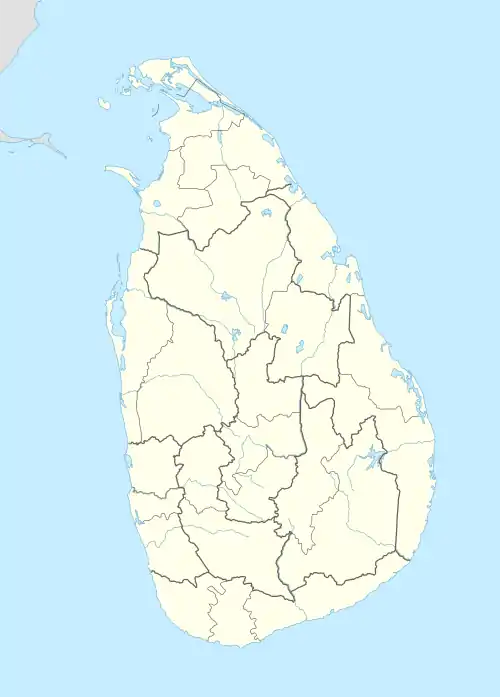| 1985 anti-Tamil pogrom in Karaitivu | |
|---|---|
 Karaitivu Karaitivu (Sri Lanka) | |
| Location | Karaitivu, Ampara District, Sri Lanka |
| Coordinates | 7°22′0″N 81°50′0″E / 7.36667°N 81.83333°E |
| Date | 12 April 1985 – 14 April 1985 |
Attack type | Massacre, arson, rape |
| Weapons | Guns, knives, stones, burning. |
| Deaths | 11 Tamil civilians |
| Injured | 40 hospitalised, several raped, 2000 homes burned, 15,000 rendered homeless |
| Perpetrators | Sri Lankan Muslim mobs, Sri Lankan security forces |
The 1985 anti-Tamil pogrom in Karaitivu refers to the organised violence directed at the Tamil civilian population of Karaitivu, Ampara by Sri Lankan Muslim mobs aided by Sri Lankan security forces.[1][2][note 1]
In April 1985, President J. R. Jayewardene sent M. H. Mohamed, along with his supporters to attack Tamils in the village of Karaitivu (Ampara).[4][3] A mob of 3000 Sri Lankan Muslim youth with the support of the security forces killed several Tamils, raped several women and burned over 2000 Tamil homes, rendering 15,000 Tamils homeless.[5][4][6][7] Shops were also looted and several Hindu temples destroyed including a temple of Pattini, where the idols were broken.[8]
According to Muslim journalist Qadri Ismail, 11 people were killed and 40 hospitalised during the ensuing violence between 12 April and 14 April. He also visited the area a month earlier and noted there was no evidence that the Muslims had felt sufficiently threatened to resort to such violence, which would only bring them insecurity.[3]
On 12 April 1985, Muslim minister A.L.A. Majeed accused an outside force of instigating the attacks:
"The Tamils and Muslims have been living peacefully for hundreds of years. I wish to bring to your notice that certain sinister forces and self-interested parties are trying to bring about a violent clash between Tamils and Muslims. Therefore, Muslims should be vigilant. We learn that certain fake politicians are doing their damnedest to provoke a violent ethnic conflict between the Tamils and the Muslims in the Eastern province which will only result in the loss of life and property."[6][3]
Similarly, Minister Savumiamoorthy Thondaman told the parliament that "7 lorries and 2 jeeps filled with thugs had gone from Colombo to the Eastern Province to provoke trouble".[3]
On 17 April 1985, a further 27 Tamil civilians in the area were murdered by the STF.[5]
See also
Notes
References
- ↑ Ismail, Qadri (1985). "Sri Lanka's Ethnic Conflict and Muslims". Economic and Political Weekly. 20 (19): 830–833. ISSN 0012-9976.
- ↑ Miller, Phil (2020). Keenie Meenie: the British mercenaries who got away with war crimes. London: Pluto Press. pp. 158–164. ISBN 978-1-78680-584-3.
- 1 2 3 4 5 Hoole, Rajan (14 November 2014). "The East Erupts: Mossad Again?". Colombo Telegraph. Retrieved 2 November 2023.
- 1 2 Imtiyaz, A. R.M.; Hoole, S. R.H. (2011). "Some Critical Notes on the Non-Tamil Identity of the Muslims of Sri Lanka, and on Tamil–Muslim Relations". South Asia: Journal of South Asian Studies. 34 (2): 208–231. doi:10.1080/00856401.2011.587504.
- 1 2 "POLICE COMMANDOS JOIN IN VIOLENCE". Tamil Times. April 1985. pp. 1–19.
- 1 2 "VIOLENCE IN EAST SRI LANKA PLANNED AND INSTIGATED". Tamil Times. May 1985. p. 4.
- ↑ "Tamil-Muslim clashes or State-directed violence against Tamils?" (PDF). Tamil Information. Vol. 1, no. 8. 15 May 1985. p. 3.
- ↑ Tharmalingam, K.N. (November 2003). "New Year's Bloody Dawn: Karativu 1985". Northeastern Herald.